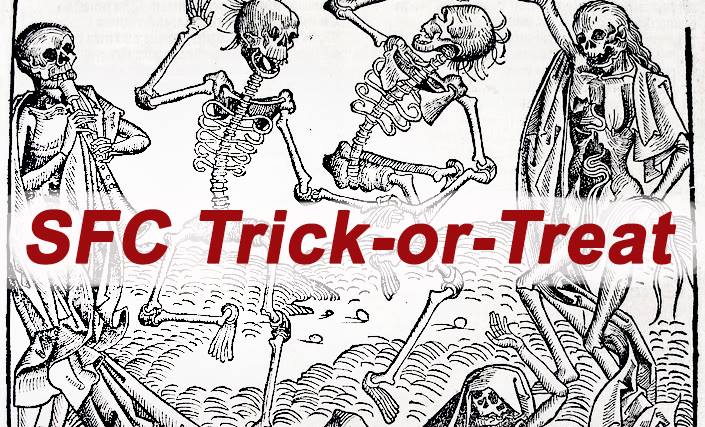No matter what the calendar may say, it isn’t Halloween for me until I’ve listened to Danse Macabre by Camille Saint-Saëns. This orchestral tone poem, composed in 1874, evokes the holiday’s magical and mysterious nature like nothing else.
You’re probably familiar with the piece, even if you don’t know it by name. It regularly surfaces in pop culture. For example, it featured prominently in a standout episode of Buffy the Vampire Slayer, “Hush” (1999), as Giles delivers a silent lecture about The Gentlemen and how to kill them. More recently, it’s served as the score for a series of Jameson’s Irish Whisky commercials.
I first heard the piece one October in elementary school music class. Our teacher showed us a filmstrip (you don’t remember those? Now that’s scary!) that illustrated in pictures the scenes Saint-Saëns illustrated in sound. It may have even been this one, although, for a better performance of the piece as well as a helpful on-screen listening guide, I recommend this instead:
From the moment Death—by some accounts, the Devil—mis-tuned his fiddle, I was hooked. I’m sure the cartoony pictures of skeletons dancing in a graveyard interested me, but I know I fell in love with the music itself. I went home and told my parents I wanted to hear Danse Macabre again. They took me to our local public library—the first trip to a public library I can remember, which may be another reason I regard this piece with such fondness—so we could check out a vinyl LP that had Danse Macabre on one side and selections from Saint-Saëns’ Carnival of the Animals on the other. Although I’d eventually appreciate it, I had no use for Saint-Saëns’ other work as a kid: I just wanted to listen to Danse Macabre over and over, and I did. Each October, I still do.
Why do I love this music so much? I’m honestly not sure. Not for any occult or death-obsessed reasons. For a long time, I felt vaguely guilty about enjoying it, although neither my parents nor anyone else ever shamed me for it. Still, a song that’s ultimately based in medieval superstition about the dead kicking up their desiccated heels—or perhaps, according to the New Grove Dictionary of Music, “in the customs of medieval gravediggers’ guilds” (better not to know too much about that, I suspect)? It seems a little weird, right? But Saint-Saëns crafted such a skillful score, it’s hard to resist.
I don’t possess the musical vocabulary to talk adequately about its virtues, but others do. In program notes for the Columbus Indiana Philarmonic, critic David Bowden points out that the Devil’s violin “is purposely mistuned down a half step to a tritone, also known as the ‘devil’s interval,’ as a part of the soloist’s challenge. This means that the soloist has to re-finger all of the notes on that string.” He also notes that you can hear the medieval plainchant Dies Irae, a hymn about God’s wrath on the Day of Judgment, “lightheartedly played in the woodwinds and harp about two and a half minutes into the piece in a major key. [The dead] are having fun dancing!”
I guess it’s that blend of fear and fun that appeals to me, and informs my perspective on Halloween as a whole. It’s ok, every now and then, to let our imaginations rattle around in the dark, as Saint-Saëns xylophonic skeletons do, because midnight is fleeting and dawn is just a few hours away. And for Christians, especially, the darkness of death is not worthy of ultimate fear: “The night is nearly over; the day is almost here” (Romans 13.12, NIV).


Leave a Reply